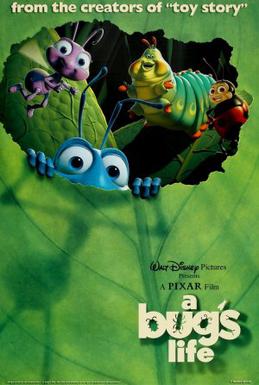
A Bug's Life is a 1998 American animated comedy film produced by Pixar Animation Studios for Walt Disney Pictures. It is Pixar's second feature-length film, following Toy Story (1995). The film was directed by John Lasseter, co-directed by Andrew Stanton, and produced by Darla K. Anderson and Kevin Reher, from a screenplay written by Stanton, Donald McEnery, and Bob Shaw, and a story conceived by Lasseter, Stanton, and Joe Ranft. It stars the voices of Dave Foley, Kevin Spacey, Julia Louis-Dreyfus, and Hayden Panettiere. In the film, a misfit ant named Flik, looks for "tough warriors" to save his ant colony from a protection racket run by a gang of grasshoppers. However, the "warriors" he brings back were a troupe of Circus Bugs. The film's plot was initially inspired by Aesop's fable The Ant and the Grasshopper.

A horn is a permanent pointed projection on the head of various animals that consists of a covering of keratin and other proteins surrounding a core of live bone. Horns are distinct from antlers, which are not permanent. In mammals, true horns are found mainly among the ruminant artiodactyls, in the families Antilocapridae (pronghorn) and Bovidae. Cattle horns arise from subcutaneous connective tissue and later fuse to the underlying frontal bone.
Lock, Stock... is a seven-part British television crime drama series, co-written and created by Guy Ritchie, as a spin-off from his 1998 film Lock, Stock and Two Smoking Barrels. The series first broadcast on Channel 4 on 29 May 2000 with a feature-length pilot, Lock, Stock and Four Stolen Hooves.

Turkish folk dances are the folk dances of Turkey. Facing three seas, straddling important trade routes, Turkey has a complex, sophisticated culture, reflected in the variety of its dances. The dominant dance forms are types of line dance. There are many different types of folk dances performed in various ways in Turkey. Zeybek, Teke Zortlatması in Aegean region, Bar in Erzurum province, Halay in the central, southern, eastern, and southeastern parts of the country, Hora in Thrace, Horon in the eastern Black Sea region, Spoon dances in and around Konya, and Lezginka in Kars and Ardahan are some of the best known examples of these.
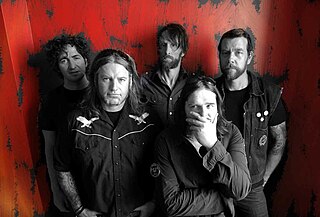
Head Like a Hole is a rock band from Wellington, New Zealand. The group is named after the Nine Inch Nails song of the same name.
Marvin the Tap-Dancing Horse is a Canadian children's animated television series co-produced by Nelvana and Hong Guang Animation for Teletoon and PBS Kids. Among the series' executive producers are Michael Paraskevas and Betty Paraskevas, creators of Maggie and the Ferocious Beast, who also created the book that the show is based on. It tells the stories of a young horse named Marvin who is part of a carnival. Some episodes include original songs to help illustrate the theme or accompany montages that carry the story forward.

Mekedatu is a location along Kaveri in the border of Chamarajanagar and Ramanagara Districts. From this point, about 3.5 kilometers downstream, the river Kaveri flows through a deep and narrow gorge. Mekedatu' means 'goat's leap' in Kannada. The name comes from an event which is believed to have been witnessed by herdsmen in that area a long time ago. It is said that a goat being chased by a tiger made a desperate attempt to save its life by leaping from one side of the gorge and managed to cross over the raging river below, whereas the tiger did not attempt to replicate this feat, and abandoned the chase. The point where the goat leapt has widened since then from erosion caused by the river Cauvery. It is about 110 km from Bengaluru via Kanakapura. There is also some mythological significance to this place. In one version, the goat (meke) that is believed to have leapt across the Kaveri was Lord Shiva in disguise. On both rocky precipices of the gorge, one can find strange holes, whose shapes resemble goats' hooves, though several times larger. It is believed that only divine goats could have marked their 'footprints' in such hard rocks.
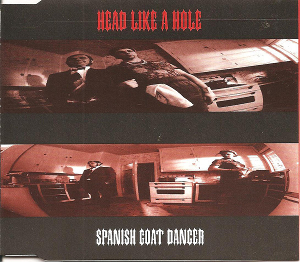
Spanish Goat Dancer is an EP released by New Zealand band, HLAH in 1994 on Wildside Records. Spanish Goat Dancer is off the album Flik Y'Self Off Y'Self. The songs Hitskin and 7 Stripes of the Maumau are covers of Hallelujah Picassos
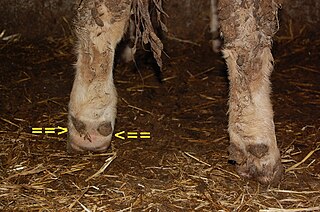
Foot rot, also known as foul-in-the-foot, interdigital necrobacillosis or infectious pododermatitis, is a hoof infection commonly found in sheep, goats, and cattle. As the name suggests, it rots away the foot of the animal, more specifically the area between the two toes of the affected animal. It is extremely painful and contagious. It can be treated with a series of medications, but if not treated, the whole herd can become infected. The cause of the infection in cattle is two species of anaerobic bacteria, Fusobacterium necrophorum and Bacteroides melaninogenicus. Both bacteria are common to the environment in which cattle live, and Fusobacterium is present in the rumen and fecal matter of the cattle. In sheep, F. necrophorum first invades the interdigital skin following damage to the skin, and causes interdigital lesions and slight inflammation. The second stage of the disease is marked by the invasion of the foot by the foot rot bacterium Dichelobacter nodosus, a Gram-negative anaerobe. Usually, an injury to the skin between the hooves allows the bacteria to infect the animal. Another cause of foot rot may be high temperatures or humidity, causing the skin between the hooves to crack and let the bacteria infect the foot. This is one of the reasons foot rot is such a major problem in the summer. Foot rot is easily identifiable by its appearance and foul odor. Treatment is usually with an antibiotic medication, and preventing injury to the feet is the best way to prevent foot rot.
Mopatop's Shop is a children's television series that premiered on CITV in the UK on 4 January 1999. 260 ten-minute episodes were made and aired daily. It was a co-production between Jim Henson Television and Carlton Television. After it finished its run in 2005 it was repeated for several years afterwards until 2010.
Egil One-Hand is a berserker hero from the Icelandic legendary saga Egils saga einhenda ok Ásmundar berserkjabana.
Fann aṭ-Ṭanbūra is a traditional music and dance genre in the Arab states of the Persian Gulf, especially Bahrain, Kuwait and Oman. Musically, the tanbūra instrument plays a central role, along with several drums and the manjur— an instrument made from a large number of goat hooves attached to a type of apron which is wrapped around the waist of the performer.

"Better Off As Two" is a song by British electropop singer Frankmusik from his debut album Complete Me.
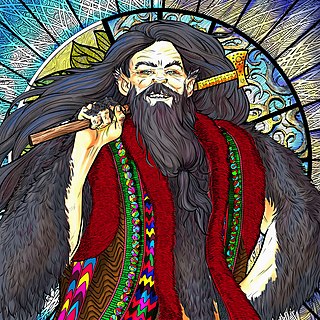
The Chuhaister is a Ukrainian tutelary deity of the forests. He is specific to the Ukrainian Carpathians. It's a fantastic image in Ukrainian mythology, unknown to other Slavic peoples.

Girls Le Disko is a remix compilation by American band Shiny Toy Guns. It was released on December 15, 2009 on Ultra Records.

The Devil Makes Work for Idle Hands is a greatest hits album released by the New Zealand band Head Like A Hole in 2009 in support of their 2009 reunion tour.

It's Tough to Be a Bug! is a 9-minute-long 3D film based on the 1998 Disney·Pixar film A Bug's Life, using theater lighting, 3-D filming techniques, audio-animatronics and various special effects. Flik, a character from the movie, hosts the show and educates the audience on why bugs should be considered friends. It was the first Pixar attraction to open in a Disney park.

Goat throwing was a festival celebrated in the town of Manganeses de la Polvorosa, province of Zamora, Spain, on the fourth Sunday of January. The festival coincided with the commemoration of Saint Vincent the Martyr.

Chajchas are a small percussion instrument of the rattle family, typically made from goat or sheep hooves, and originating in the Central Andes. The instrument is used in traditional rituals and ceremonies, and can also be heard in much of the folk music of the region, especially the countries of Colombia, Bolivia, Peru, Chile, Ecuador.
Se’īrīm are demons. Sa’ir was the ordinary Hebrew word for "he-goat", and it is not always clear what the word's original meaning might have been. But in early Jewish thought, represented by targumim and possibly 3 Baruch, along with translations of the Hebrew Bible such as the Peshitta and Vulgate, the se’īrīm were understood as demons. They are considered to be the lowest of all created beings. Se'īrīm are frequently compared with the shedim of Hebrew tradition, along with satyrs of Greek mythology, fauns of Roman mythology and jinn of Arab culture. Julius Wellhausen suggested that they rather correspond to the Arabian Ifrit.














